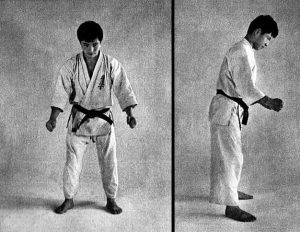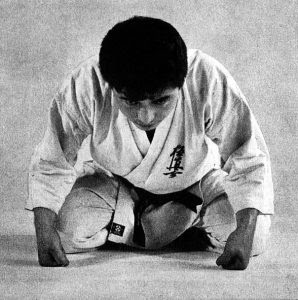Below is an expaination of the concept of reihō.
While there are some differences from what we practice at our dojo,
hopefully this will give some insight into the core principles of all martial
arts. Courtesy and respect must be integrated into your study of
karate-do. O Sensei Dr. Tsuyoshi Chitose, founder of Chito Ryu,
tells us that "Without courtesy, the soul is lost."
Note: My apology to the original author for
not giving proper attribution. The source information could not be
located.
The meaning of reihō can be sometimes
translated as "etiquette," "respect" or
"courtesy." It is a very important concept in Japanese culture,
including traditional Japanese martial arts. It is not a "ceremony"
or a "ritual" per se; as this may construe that it is performing an
exotic spiritual or religious act without meaning, which is not the case. In
Japan this act is considered ancestral reverence. While reihō may have
the meaning of "etiquette," this does not adequately describe its
many connotations.
Reihō is in many ways a code of conduct, which in Japan is applied to
one's everyday life. For example; at school, at work, at home, when they visit
their doctor, ect. In Japan "rei" is not taught to the
Japanese – usually only to foreigners – because it is generally known due to
its culture. In our western culture (specifically American) we tend not to
"show respect." And when we do give respect we often express it by
saying it. And when we do say that we respect someone as in "I respect you"
it is seldom given out. So, reihō is a foreign concept to westerners.
Since we are dealing with a Japanese martial
art, reihō is included in the Genbukan. It is the basis of all
traditional Japanese martial arts, no matter what their roots are. Without reihō
in martial arts it would be nothing more, nor better, than hoodlums
fighting in the streets. In the Genbukan the purpose of reihō has
two purposes. First, it is a way of paying respect to the tradition, the
teacher, and the students. Secondly, it provides a degree of safety, especially
during the use of weapons. In the Genbukan, as well as most Japanese
martial arts, everything begins and ends with reihō.
Entering the Dōjō
When entering the dōjō, stand in a
natural posture and perform shizen rei (standing bow) to anyone present,
and say one of the following: ohayō gozaimasu (good morning), konnichiwa
(good afternoon), or konbanwa
(good evening). If you are already at the dōjō it is customary to
stand up and greet the teacher when he arrives.
Entering and Exiting the Training
Floor
Before entering on the training floor, face
towards the kamidana (dōjō shrine) and perform shizen rei.
If you are training outside you will face to the north and perform shizen
rei.
Note: If you are late to class, quickly prepare yourself for training.
Upon entering the dōjō, immediately step off to the side and perform the
shinzen rei.
Beginning and Ending of Class
The beginning and ending of class is
signified by a formal bowing consisting of two parts: shinzen rei (bow
in acknowledgment of the tradition) and shi rei (bow to the teacher).
1. Beginning: Seiretsu – Form
a line
At the beginning of class the instructor will
say, "Dewa keiko wo hajimeru" (begin training). Thesenpei (the
senior) will command everyone to line up in a row by saying, "Seiretsu!"
All the students will line up by rank and kneel into seiza (a seated
posture) with the senpei at the lead, facing the kamidana (dōjō
shrine). The instructor will move to the front of the class and kneel into seiza
facing the class.
2. Mokusō – Meditation
The senpei will then instruct everyone
to perform mokusō (Japanese term for meditation to "clear one's
mind"). Everyone will then place their hands in their laps, right hand
over left, thumbs touching, and then lightly closing eyes to clear their minds.
After a few minutes, the instructor will then recite the "Ninniku
Seishin" poem with everyone following his lead. The instructor will
then stop the meditation by saying "Mokusō yame." Everyone
will then open their eyes and places their hands on the thighs.
3. Shinzen Rei – Bow before
the shrine
The instructor turns around and faces the kamidana
(dōjō shrine). He then places his hands ingasshō (hands
together in front of his chest). The students with then follow his lead by
doing the same gasshō. The instructor then recites the following phrase,
"Chihayafuru kami no oseiwa tokoshieni tadashiki kokoro mi wo
mamoruran." (The teachings of God never changes throughout eternity
and will protect you if you have a correct mind/heart/spirit). And then he
says, "Shikin haramitsu daikōmyō!" (The sounds of words in our
reach for perfection will lead us to the powerful light). The students then
repeats, "Shikin haramitsu daikōmyō!" Everyone then claps
twice, performs a bow, and claps one more time followed by one more bow.
Note: If the Teacher is not in class then the senpei does NOT go
to the front of class where the teacher sits. He stays in the usual place at
the far right.
4. Shi Rei – Bow to the
teacher
The instructor then turns around and faces
the class. The senpei will command everyone to correct their posture and
bow to the teacher by saying "Shisei wo tadashite, Sensei ni
rei!" The students then bows to the instructor, while the instructor does
the same to the students, with everyone saying, "Onegai shimasu."
(Please assist me).
Note: if the teacher is not in class, the the senpei says “Shisei
wo tadashite, shinzen ni rei!”
5. Ending: Seiretsu – Form a
line
At the end of class the instructor will say,
"Keiko owari" (Training has ended). The senpei (the
senior) will command everyone to line up in a row by saying, "Seiretsu!"
All the students will line up by rank and kneel into seiza (a seated
posture) with the senpei at the lead, facing the kamidana (dōjō
shrine). The instructor will move to the front of the class and kneel into
seiza facing the class.
6. Mokusō – Meditation
The senpei will then instruct everyone
to perform mokusō (Japanese term for meditation to "clear one's
mind"). Everyone will then place their hands in their laps, right hand
over left, thumbs touching, and then lightly closing eyes to clear their minds.
After a few minutes, the instructor will then stop the meditation by saying
"Mokusō yame." Everyone will then open their eyes and places
their hands on the thighs.
7. Shinzen Rei – Bow before
the shrine
The instructor turns around and faces the kamidana
(dōjō shrine). He then places his hands ingasshō (hands
together in front of his chest). The students with then follow his lead by
doing the same gasshō. The instructor then recites the following phrase,
"Chihayafuru kami no oseiwa tokoshieni tadashiki kokoro mi wo
mamoruran." (The teachings of God never changes throughout eternity
and will protect you if you have a correct mind/heart/spirit). And then he
says, "Shikin haramitsu daikōmyō!" (The sounds of words
in our reach for perfection will lead us to the powerful light). The students
then repeats, "Shikin haramitsu daikōmyō!" Everyone then claps
twice, performs a bow, and claps one more time followed by one more bow.
Note: If the Teacher is not in class then the senpei does NOT go
to the front of class where the teacher sits. He stays in the usual place at
the far right.
8. Shi Rei – Bow to the
teacher
The instructor then turns around and faces
the class. The senpei will command everyone to correct their posture and
bow to the teacher by saying "Shisei wo tadashite, Sensei ni rei!"
The students then bows to the instructor saying, "Arigatō gozaimashita."
(Thank you). The instructor bows to the class while saying, "Gokurō
samadeshita" (thank you very much for your efforts). The senpai will
then give a command to the students to bow to each other by saying, "Sōgo
ni rei." Everyone will then bow to each other and says "Arigatō
gozaimashita."
Note: if the teacher is not in class, the senpei says "Shisei
wo tadashite, shinzen ni rei!"
Exiting the Dōjō
Upon leaving the dōjō, stand in a
natural posture and perform shizen rei (standing bow) and say one of the
following: oyasumi nasai (good night), or shitsurei shimasu (pardon
me leaving).



